Financial Analysis of a Restaurant: Costs, Funding, and Ratio Report
VerifiedAdded on 2020/07/23
|15
|4183
|33
Report
AI Summary
This report provides a detailed financial analysis of a restaurant business. It begins by discussing various sources of funding, including friends and family, angel investors, bank loans, and retained earnings. The report then explores different methods of income generation, such as offering complementary services, direct mailing, contests, and social media strategies. It outlines the elements of cost, gross profit, and selling prices, categorizing costs into material, labor, and overhead expenses, and distinguishing between fixed and variable costs. The report also examines methods for controlling stock and cash, including the just-in-time approach, economic order quantity (EOQ), balancing, securing cash, and routine reconciliation. Furthermore, the report includes the structure of a trial balance and the preparation of a balance sheet. It outlines the process and purpose of budgetary control, emphasizing its role in planning, cost control, and performance enhancement. The report computes key financial ratios and provides recommendations for improving the restaurant's performance. Finally, it categorizes various costs and presents a marginal costing statement, concluding with a discussion of the significance of break-even analysis. The report offers a comprehensive overview of financial management in the hospitality industry.
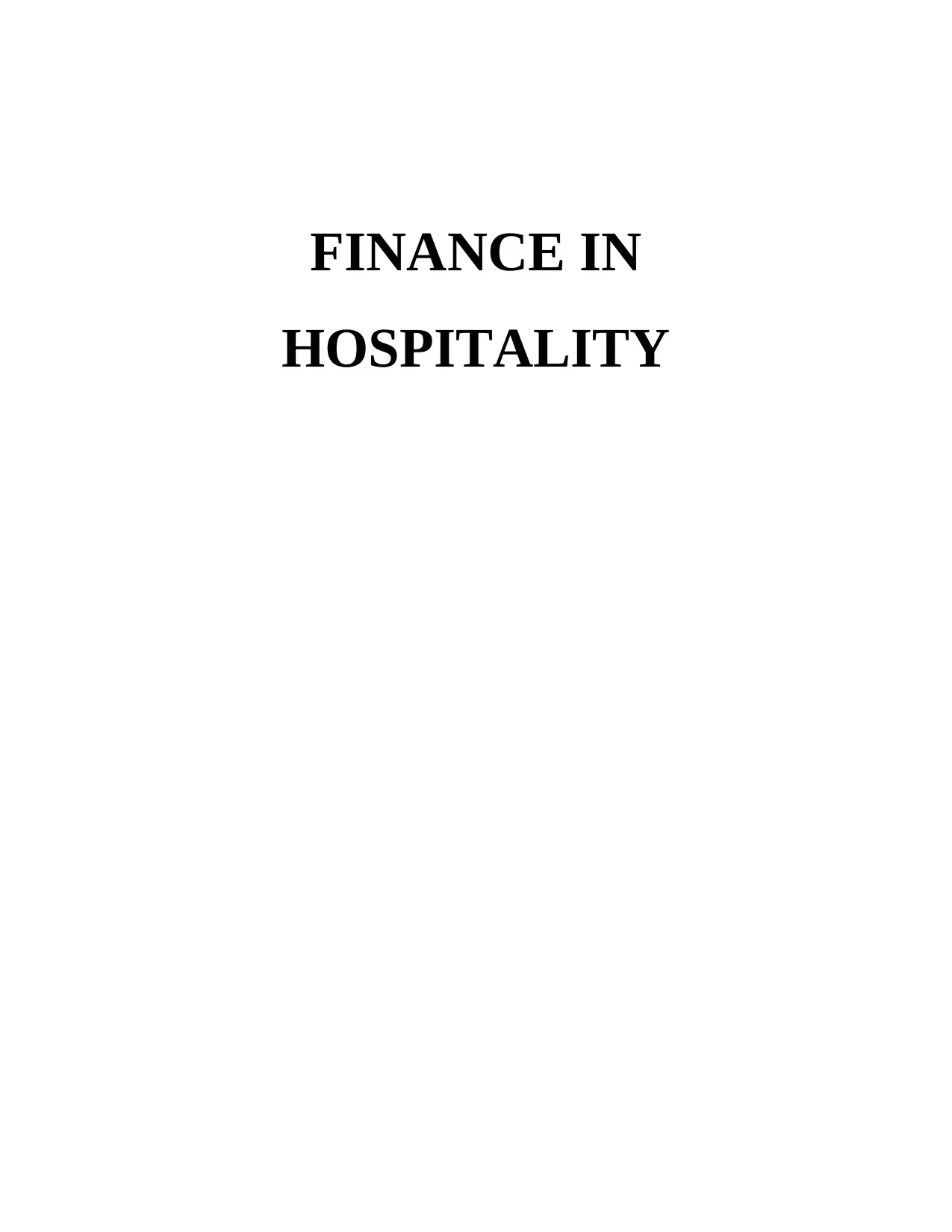
FINANCE IN
HOSPITALITY
HOSPITALITY
Paraphrase This Document
Need a fresh take? Get an instant paraphrase of this document with our AI Paraphraser
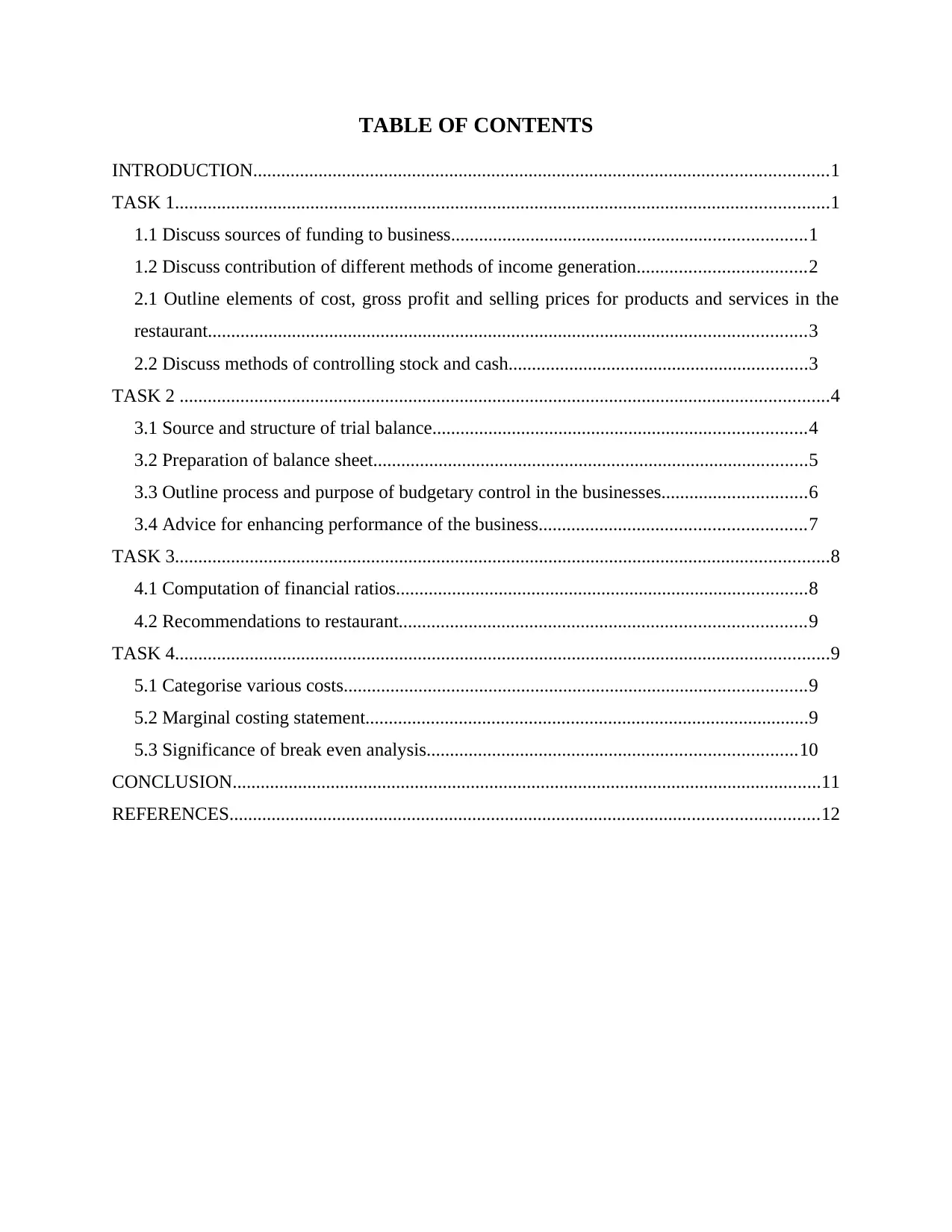
TABLE OF CONTENTS
INTRODUCTION...........................................................................................................................1
TASK 1............................................................................................................................................1
1.1 Discuss sources of funding to business............................................................................1
1.2 Discuss contribution of different methods of income generation....................................2
2.1 Outline elements of cost, gross profit and selling prices for products and services in the
restaurant................................................................................................................................3
2.2 Discuss methods of controlling stock and cash................................................................3
TASK 2 ...........................................................................................................................................4
3.1 Source and structure of trial balance................................................................................4
3.2 Preparation of balance sheet.............................................................................................5
3.3 Outline process and purpose of budgetary control in the businesses...............................6
3.4 Advice for enhancing performance of the business.........................................................7
TASK 3............................................................................................................................................8
4.1 Computation of financial ratios........................................................................................8
4.2 Recommendations to restaurant.......................................................................................9
TASK 4............................................................................................................................................9
5.1 Categorise various costs...................................................................................................9
5.2 Marginal costing statement...............................................................................................9
5.3 Significance of break even analysis...............................................................................10
CONCLUSION..............................................................................................................................11
REFERENCES..............................................................................................................................12
INTRODUCTION...........................................................................................................................1
TASK 1............................................................................................................................................1
1.1 Discuss sources of funding to business............................................................................1
1.2 Discuss contribution of different methods of income generation....................................2
2.1 Outline elements of cost, gross profit and selling prices for products and services in the
restaurant................................................................................................................................3
2.2 Discuss methods of controlling stock and cash................................................................3
TASK 2 ...........................................................................................................................................4
3.1 Source and structure of trial balance................................................................................4
3.2 Preparation of balance sheet.............................................................................................5
3.3 Outline process and purpose of budgetary control in the businesses...............................6
3.4 Advice for enhancing performance of the business.........................................................7
TASK 3............................................................................................................................................8
4.1 Computation of financial ratios........................................................................................8
4.2 Recommendations to restaurant.......................................................................................9
TASK 4............................................................................................................................................9
5.1 Categorise various costs...................................................................................................9
5.2 Marginal costing statement...............................................................................................9
5.3 Significance of break even analysis...............................................................................10
CONCLUSION..............................................................................................................................11
REFERENCES..............................................................................................................................12
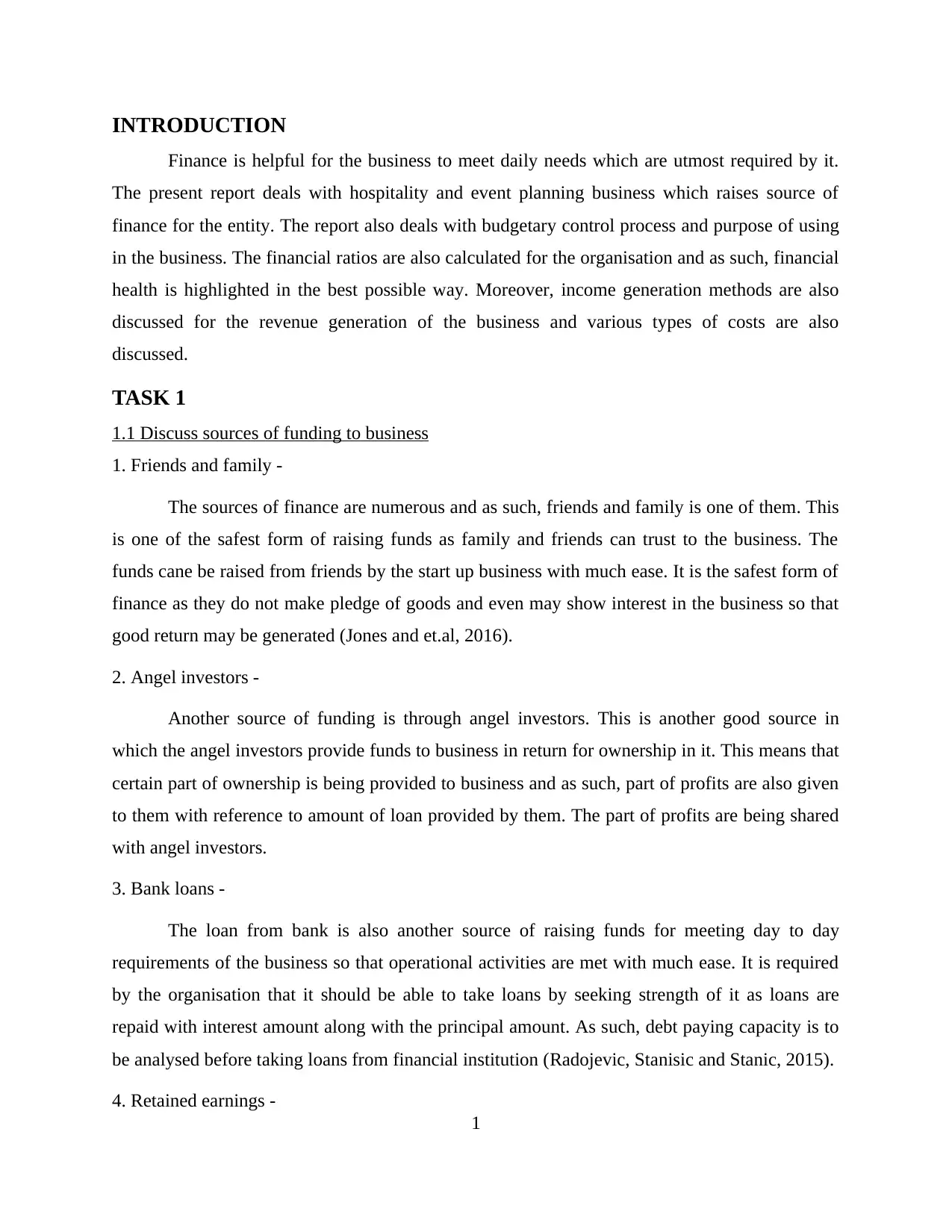
INTRODUCTION
Finance is helpful for the business to meet daily needs which are utmost required by it.
The present report deals with hospitality and event planning business which raises source of
finance for the entity. The report also deals with budgetary control process and purpose of using
in the business. The financial ratios are also calculated for the organisation and as such, financial
health is highlighted in the best possible way. Moreover, income generation methods are also
discussed for the revenue generation of the business and various types of costs are also
discussed.
TASK 1
1.1 Discuss sources of funding to business
1. Friends and family -
The sources of finance are numerous and as such, friends and family is one of them. This
is one of the safest form of raising funds as family and friends can trust to the business. The
funds cane be raised from friends by the start up business with much ease. It is the safest form of
finance as they do not make pledge of goods and even may show interest in the business so that
good return may be generated (Jones and et.al, 2016).
2. Angel investors -
Another source of funding is through angel investors. This is another good source in
which the angel investors provide funds to business in return for ownership in it. This means that
certain part of ownership is being provided to business and as such, part of profits are also given
to them with reference to amount of loan provided by them. The part of profits are being shared
with angel investors.
3. Bank loans -
The loan from bank is also another source of raising funds for meeting day to day
requirements of the business so that operational activities are met with much ease. It is required
by the organisation that it should be able to take loans by seeking strength of it as loans are
repaid with interest amount along with the principal amount. As such, debt paying capacity is to
be analysed before taking loans from financial institution (Radojevic, Stanisic and Stanic, 2015).
4. Retained earnings -
1
Finance is helpful for the business to meet daily needs which are utmost required by it.
The present report deals with hospitality and event planning business which raises source of
finance for the entity. The report also deals with budgetary control process and purpose of using
in the business. The financial ratios are also calculated for the organisation and as such, financial
health is highlighted in the best possible way. Moreover, income generation methods are also
discussed for the revenue generation of the business and various types of costs are also
discussed.
TASK 1
1.1 Discuss sources of funding to business
1. Friends and family -
The sources of finance are numerous and as such, friends and family is one of them. This
is one of the safest form of raising funds as family and friends can trust to the business. The
funds cane be raised from friends by the start up business with much ease. It is the safest form of
finance as they do not make pledge of goods and even may show interest in the business so that
good return may be generated (Jones and et.al, 2016).
2. Angel investors -
Another source of funding is through angel investors. This is another good source in
which the angel investors provide funds to business in return for ownership in it. This means that
certain part of ownership is being provided to business and as such, part of profits are also given
to them with reference to amount of loan provided by them. The part of profits are being shared
with angel investors.
3. Bank loans -
The loan from bank is also another source of raising funds for meeting day to day
requirements of the business so that operational activities are met with much ease. It is required
by the organisation that it should be able to take loans by seeking strength of it as loans are
repaid with interest amount along with the principal amount. As such, debt paying capacity is to
be analysed before taking loans from financial institution (Radojevic, Stanisic and Stanic, 2015).
4. Retained earnings -
1
⊘ This is a preview!⊘
Do you want full access?
Subscribe today to unlock all pages.

Trusted by 1+ million students worldwide
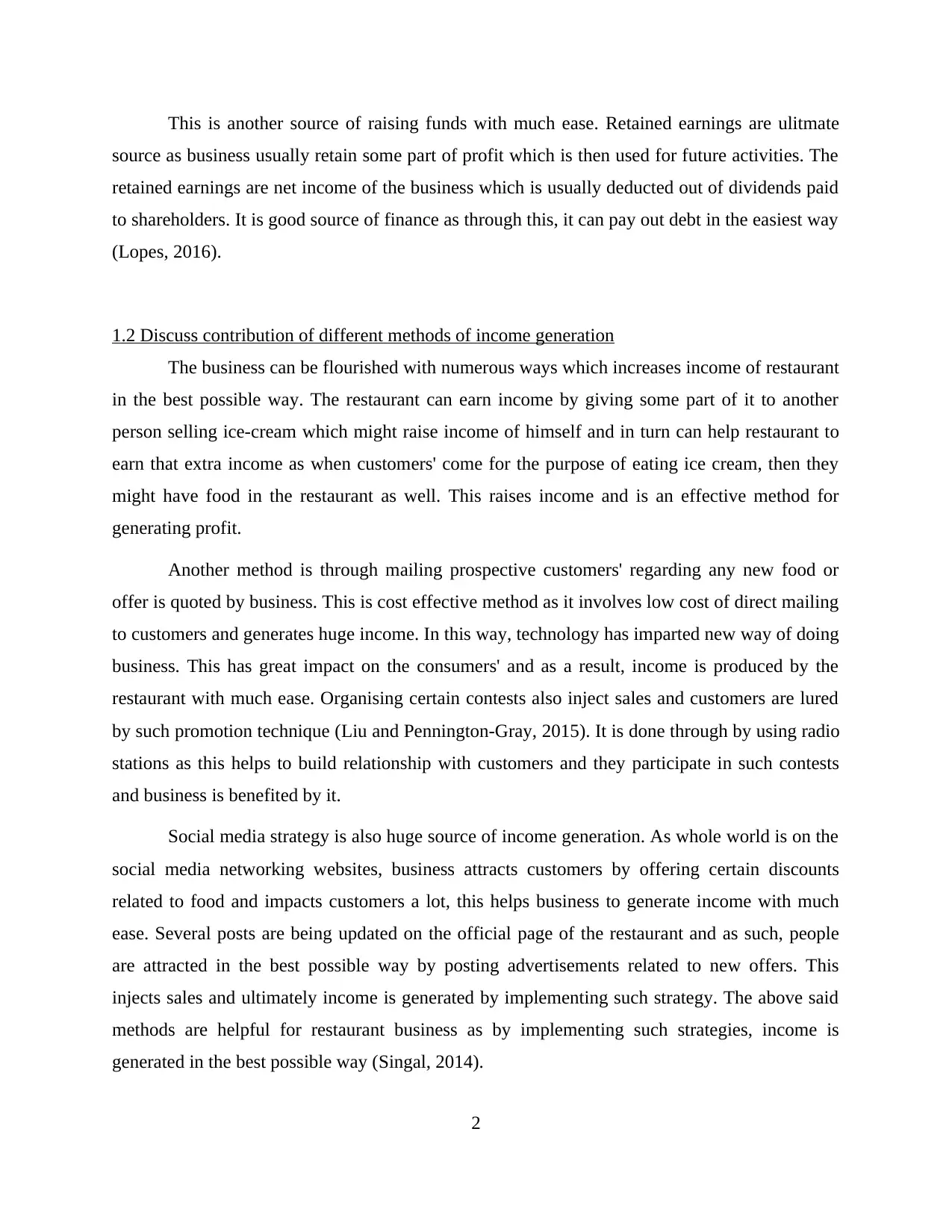
This is another source of raising funds with much ease. Retained earnings are ulitmate
source as business usually retain some part of profit which is then used for future activities. The
retained earnings are net income of the business which is usually deducted out of dividends paid
to shareholders. It is good source of finance as through this, it can pay out debt in the easiest way
(Lopes, 2016).
1.2 Discuss contribution of different methods of income generation
The business can be flourished with numerous ways which increases income of restaurant
in the best possible way. The restaurant can earn income by giving some part of it to another
person selling ice-cream which might raise income of himself and in turn can help restaurant to
earn that extra income as when customers' come for the purpose of eating ice cream, then they
might have food in the restaurant as well. This raises income and is an effective method for
generating profit.
Another method is through mailing prospective customers' regarding any new food or
offer is quoted by business. This is cost effective method as it involves low cost of direct mailing
to customers and generates huge income. In this way, technology has imparted new way of doing
business. This has great impact on the consumers' and as a result, income is produced by the
restaurant with much ease. Organising certain contests also inject sales and customers are lured
by such promotion technique (Liu and Pennington-Gray, 2015). It is done through by using radio
stations as this helps to build relationship with customers and they participate in such contests
and business is benefited by it.
Social media strategy is also huge source of income generation. As whole world is on the
social media networking websites, business attracts customers by offering certain discounts
related to food and impacts customers a lot, this helps business to generate income with much
ease. Several posts are being updated on the official page of the restaurant and as such, people
are attracted in the best possible way by posting advertisements related to new offers. This
injects sales and ultimately income is generated by implementing such strategy. The above said
methods are helpful for restaurant business as by implementing such strategies, income is
generated in the best possible way (Singal, 2014).
2
source as business usually retain some part of profit which is then used for future activities. The
retained earnings are net income of the business which is usually deducted out of dividends paid
to shareholders. It is good source of finance as through this, it can pay out debt in the easiest way
(Lopes, 2016).
1.2 Discuss contribution of different methods of income generation
The business can be flourished with numerous ways which increases income of restaurant
in the best possible way. The restaurant can earn income by giving some part of it to another
person selling ice-cream which might raise income of himself and in turn can help restaurant to
earn that extra income as when customers' come for the purpose of eating ice cream, then they
might have food in the restaurant as well. This raises income and is an effective method for
generating profit.
Another method is through mailing prospective customers' regarding any new food or
offer is quoted by business. This is cost effective method as it involves low cost of direct mailing
to customers and generates huge income. In this way, technology has imparted new way of doing
business. This has great impact on the consumers' and as a result, income is produced by the
restaurant with much ease. Organising certain contests also inject sales and customers are lured
by such promotion technique (Liu and Pennington-Gray, 2015). It is done through by using radio
stations as this helps to build relationship with customers and they participate in such contests
and business is benefited by it.
Social media strategy is also huge source of income generation. As whole world is on the
social media networking websites, business attracts customers by offering certain discounts
related to food and impacts customers a lot, this helps business to generate income with much
ease. Several posts are being updated on the official page of the restaurant and as such, people
are attracted in the best possible way by posting advertisements related to new offers. This
injects sales and ultimately income is generated by implementing such strategy. The above said
methods are helpful for restaurant business as by implementing such strategies, income is
generated in the best possible way (Singal, 2014).
2
Paraphrase This Document
Need a fresh take? Get an instant paraphrase of this document with our AI Paraphraser
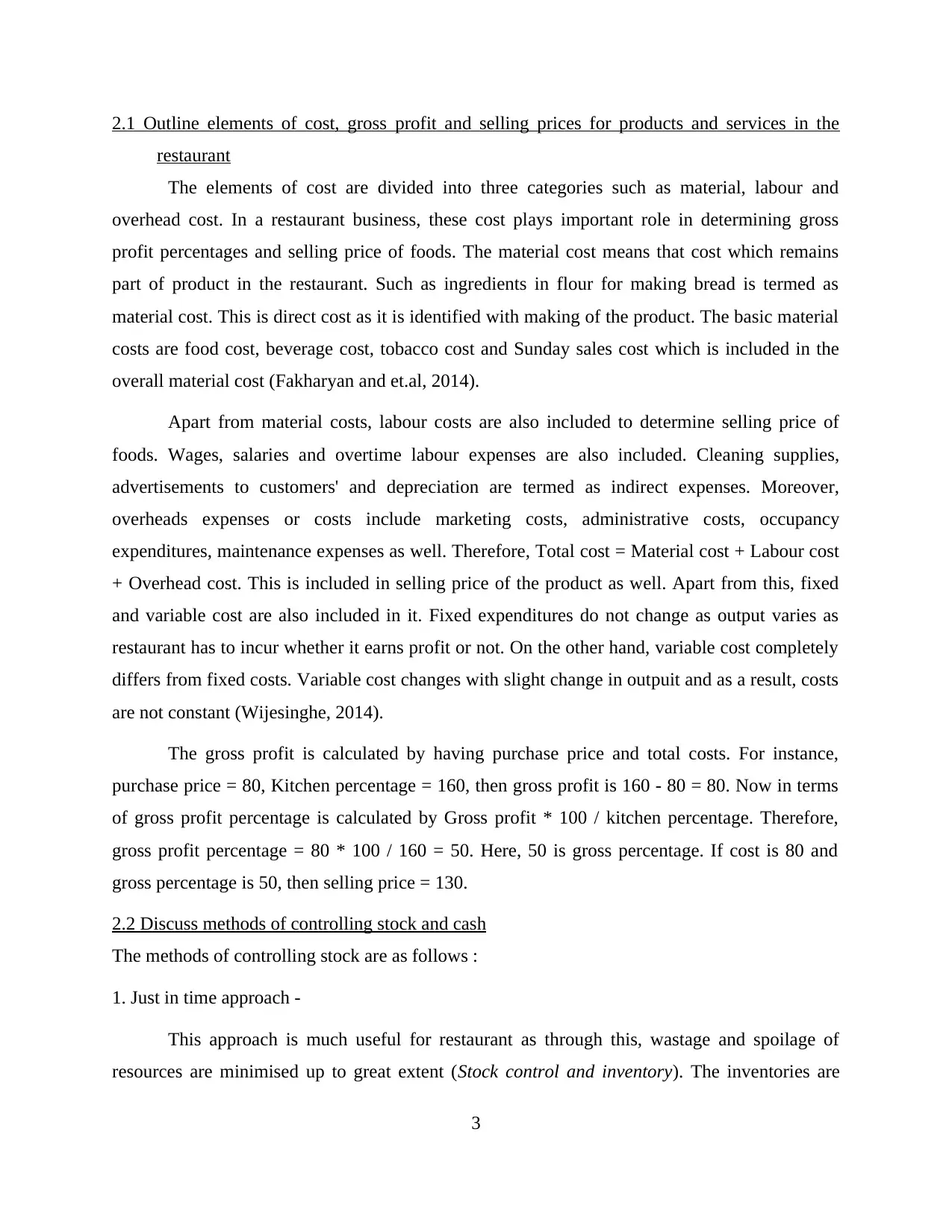
2.1 Outline elements of cost, gross profit and selling prices for products and services in the
restaurant
The elements of cost are divided into three categories such as material, labour and
overhead cost. In a restaurant business, these cost plays important role in determining gross
profit percentages and selling price of foods. The material cost means that cost which remains
part of product in the restaurant. Such as ingredients in flour for making bread is termed as
material cost. This is direct cost as it is identified with making of the product. The basic material
costs are food cost, beverage cost, tobacco cost and Sunday sales cost which is included in the
overall material cost (Fakharyan and et.al, 2014).
Apart from material costs, labour costs are also included to determine selling price of
foods. Wages, salaries and overtime labour expenses are also included. Cleaning supplies,
advertisements to customers' and depreciation are termed as indirect expenses. Moreover,
overheads expenses or costs include marketing costs, administrative costs, occupancy
expenditures, maintenance expenses as well. Therefore, Total cost = Material cost + Labour cost
+ Overhead cost. This is included in selling price of the product as well. Apart from this, fixed
and variable cost are also included in it. Fixed expenditures do not change as output varies as
restaurant has to incur whether it earns profit or not. On the other hand, variable cost completely
differs from fixed costs. Variable cost changes with slight change in outpuit and as a result, costs
are not constant (Wijesinghe, 2014).
The gross profit is calculated by having purchase price and total costs. For instance,
purchase price = 80, Kitchen percentage = 160, then gross profit is 160 - 80 = 80. Now in terms
of gross profit percentage is calculated by Gross profit * 100 / kitchen percentage. Therefore,
gross profit percentage = 80 * 100 / 160 = 50. Here, 50 is gross percentage. If cost is 80 and
gross percentage is 50, then selling price = 130.
2.2 Discuss methods of controlling stock and cash
The methods of controlling stock are as follows :
1. Just in time approach -
This approach is much useful for restaurant as through this, wastage and spoilage of
resources are minimised up to great extent (Stock control and inventory). The inventories are
3
restaurant
The elements of cost are divided into three categories such as material, labour and
overhead cost. In a restaurant business, these cost plays important role in determining gross
profit percentages and selling price of foods. The material cost means that cost which remains
part of product in the restaurant. Such as ingredients in flour for making bread is termed as
material cost. This is direct cost as it is identified with making of the product. The basic material
costs are food cost, beverage cost, tobacco cost and Sunday sales cost which is included in the
overall material cost (Fakharyan and et.al, 2014).
Apart from material costs, labour costs are also included to determine selling price of
foods. Wages, salaries and overtime labour expenses are also included. Cleaning supplies,
advertisements to customers' and depreciation are termed as indirect expenses. Moreover,
overheads expenses or costs include marketing costs, administrative costs, occupancy
expenditures, maintenance expenses as well. Therefore, Total cost = Material cost + Labour cost
+ Overhead cost. This is included in selling price of the product as well. Apart from this, fixed
and variable cost are also included in it. Fixed expenditures do not change as output varies as
restaurant has to incur whether it earns profit or not. On the other hand, variable cost completely
differs from fixed costs. Variable cost changes with slight change in outpuit and as a result, costs
are not constant (Wijesinghe, 2014).
The gross profit is calculated by having purchase price and total costs. For instance,
purchase price = 80, Kitchen percentage = 160, then gross profit is 160 - 80 = 80. Now in terms
of gross profit percentage is calculated by Gross profit * 100 / kitchen percentage. Therefore,
gross profit percentage = 80 * 100 / 160 = 50. Here, 50 is gross percentage. If cost is 80 and
gross percentage is 50, then selling price = 130.
2.2 Discuss methods of controlling stock and cash
The methods of controlling stock are as follows :
1. Just in time approach -
This approach is much useful for restaurant as through this, wastage and spoilage of
resources are minimised up to great extent (Stock control and inventory). The inventories are
3
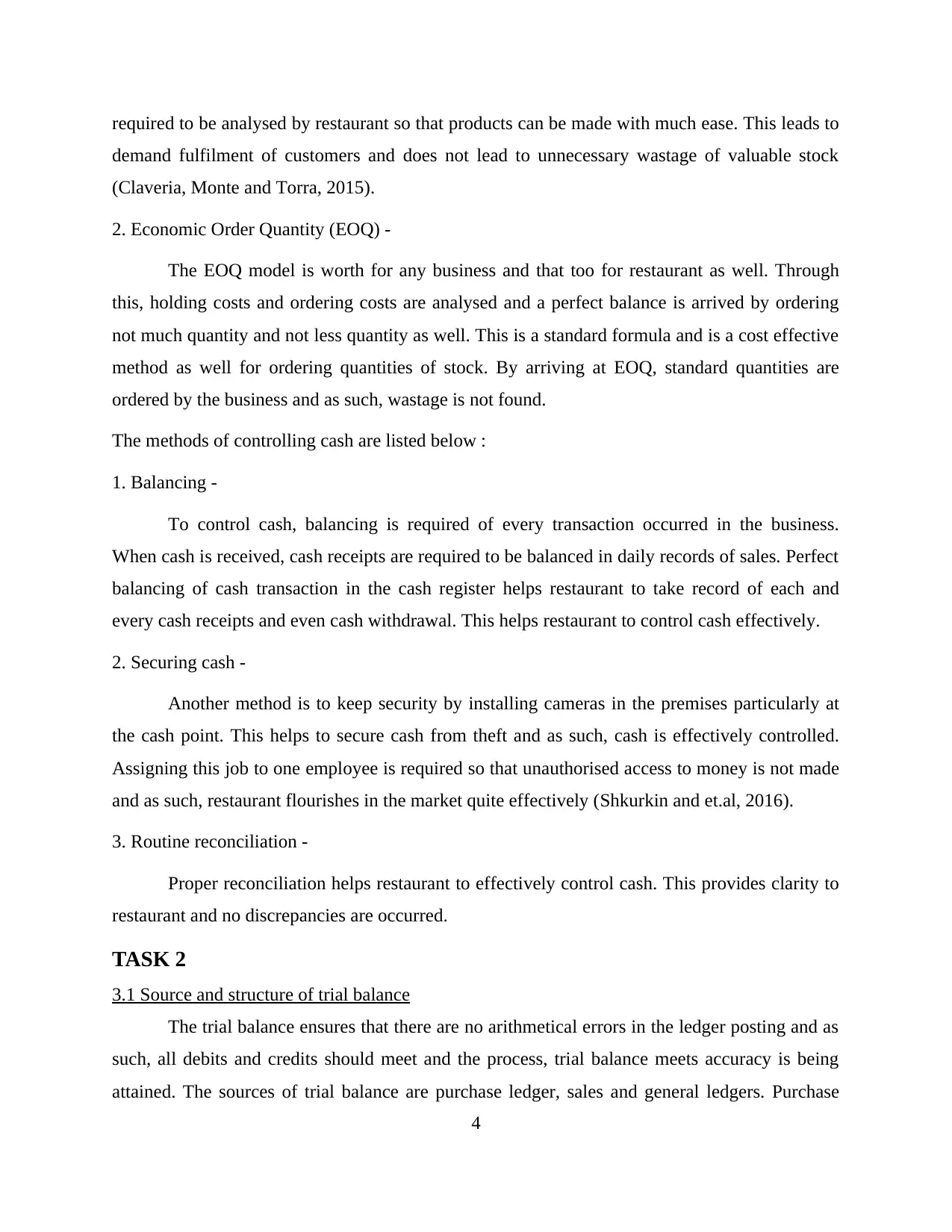
required to be analysed by restaurant so that products can be made with much ease. This leads to
demand fulfilment of customers and does not lead to unnecessary wastage of valuable stock
(Claveria, Monte and Torra, 2015).
2. Economic Order Quantity (EOQ) -
The EOQ model is worth for any business and that too for restaurant as well. Through
this, holding costs and ordering costs are analysed and a perfect balance is arrived by ordering
not much quantity and not less quantity as well. This is a standard formula and is a cost effective
method as well for ordering quantities of stock. By arriving at EOQ, standard quantities are
ordered by the business and as such, wastage is not found.
The methods of controlling cash are listed below :
1. Balancing -
To control cash, balancing is required of every transaction occurred in the business.
When cash is received, cash receipts are required to be balanced in daily records of sales. Perfect
balancing of cash transaction in the cash register helps restaurant to take record of each and
every cash receipts and even cash withdrawal. This helps restaurant to control cash effectively.
2. Securing cash -
Another method is to keep security by installing cameras in the premises particularly at
the cash point. This helps to secure cash from theft and as such, cash is effectively controlled.
Assigning this job to one employee is required so that unauthorised access to money is not made
and as such, restaurant flourishes in the market quite effectively (Shkurkin and et.al, 2016).
3. Routine reconciliation -
Proper reconciliation helps restaurant to effectively control cash. This provides clarity to
restaurant and no discrepancies are occurred.
TASK 2
3.1 Source and structure of trial balance
The trial balance ensures that there are no arithmetical errors in the ledger posting and as
such, all debits and credits should meet and the process, trial balance meets accuracy is being
attained. The sources of trial balance are purchase ledger, sales and general ledgers. Purchase
4
demand fulfilment of customers and does not lead to unnecessary wastage of valuable stock
(Claveria, Monte and Torra, 2015).
2. Economic Order Quantity (EOQ) -
The EOQ model is worth for any business and that too for restaurant as well. Through
this, holding costs and ordering costs are analysed and a perfect balance is arrived by ordering
not much quantity and not less quantity as well. This is a standard formula and is a cost effective
method as well for ordering quantities of stock. By arriving at EOQ, standard quantities are
ordered by the business and as such, wastage is not found.
The methods of controlling cash are listed below :
1. Balancing -
To control cash, balancing is required of every transaction occurred in the business.
When cash is received, cash receipts are required to be balanced in daily records of sales. Perfect
balancing of cash transaction in the cash register helps restaurant to take record of each and
every cash receipts and even cash withdrawal. This helps restaurant to control cash effectively.
2. Securing cash -
Another method is to keep security by installing cameras in the premises particularly at
the cash point. This helps to secure cash from theft and as such, cash is effectively controlled.
Assigning this job to one employee is required so that unauthorised access to money is not made
and as such, restaurant flourishes in the market quite effectively (Shkurkin and et.al, 2016).
3. Routine reconciliation -
Proper reconciliation helps restaurant to effectively control cash. This provides clarity to
restaurant and no discrepancies are occurred.
TASK 2
3.1 Source and structure of trial balance
The trial balance ensures that there are no arithmetical errors in the ledger posting and as
such, all debits and credits should meet and the process, trial balance meets accuracy is being
attained. The sources of trial balance are purchase ledger, sales and general ledgers. Purchase
4
⊘ This is a preview!⊘
Do you want full access?
Subscribe today to unlock all pages.

Trusted by 1+ million students worldwide
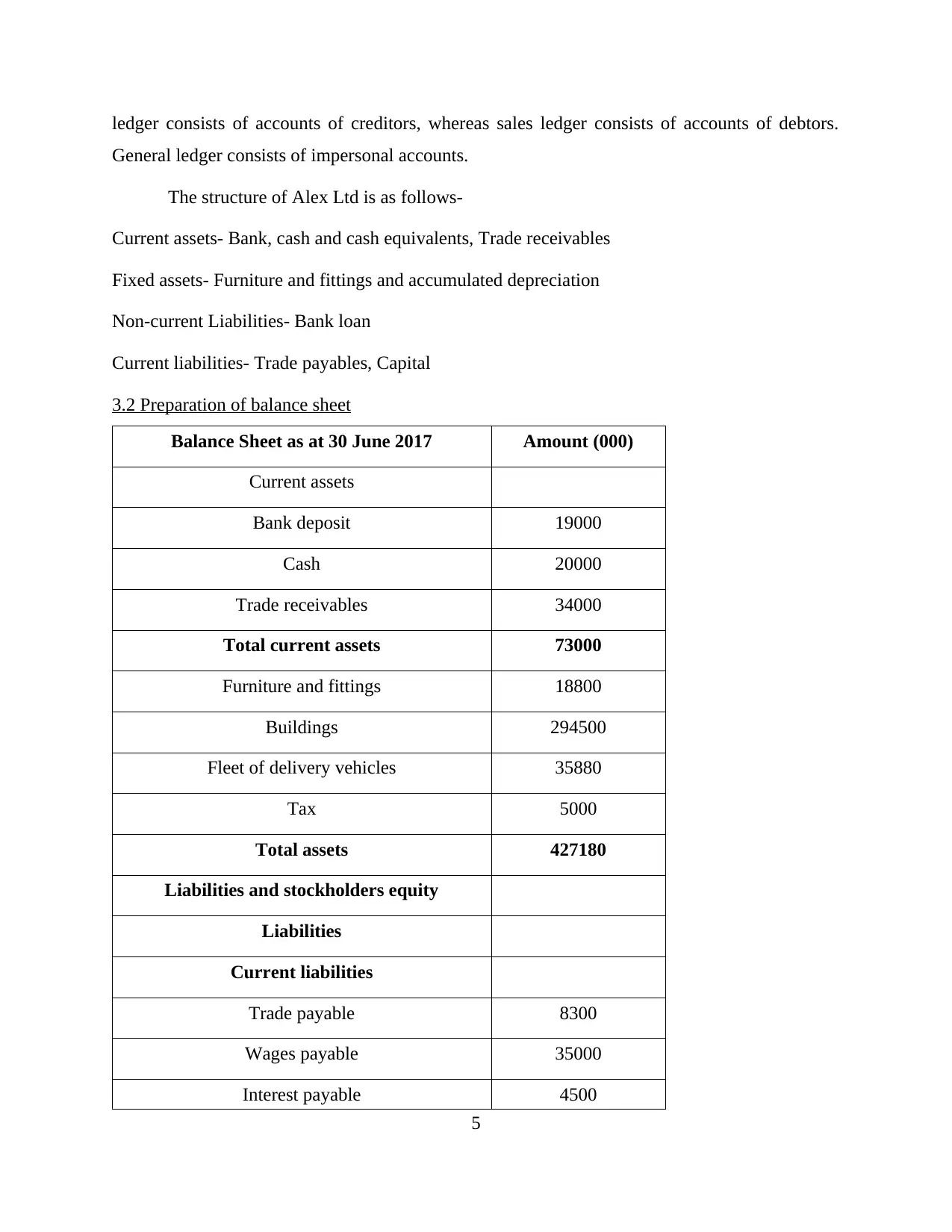
ledger consists of accounts of creditors, whereas sales ledger consists of accounts of debtors.
General ledger consists of impersonal accounts.
The structure of Alex Ltd is as follows-
Current assets- Bank, cash and cash equivalents, Trade receivables
Fixed assets- Furniture and fittings and accumulated depreciation
Non-current Liabilities- Bank loan
Current liabilities- Trade payables, Capital
3.2 Preparation of balance sheet
Balance Sheet as at 30 June 2017 Amount (000)
Current assets
Bank deposit 19000
Cash 20000
Trade receivables 34000
Total current assets 73000
Furniture and fittings 18800
Buildings 294500
Fleet of delivery vehicles 35880
Tax 5000
Total assets 427180
Liabilities and stockholders equity
Liabilities
Current liabilities
Trade payable 8300
Wages payable 35000
Interest payable 4500
5
General ledger consists of impersonal accounts.
The structure of Alex Ltd is as follows-
Current assets- Bank, cash and cash equivalents, Trade receivables
Fixed assets- Furniture and fittings and accumulated depreciation
Non-current Liabilities- Bank loan
Current liabilities- Trade payables, Capital
3.2 Preparation of balance sheet
Balance Sheet as at 30 June 2017 Amount (000)
Current assets
Bank deposit 19000
Cash 20000
Trade receivables 34000
Total current assets 73000
Furniture and fittings 18800
Buildings 294500
Fleet of delivery vehicles 35880
Tax 5000
Total assets 427180
Liabilities and stockholders equity
Liabilities
Current liabilities
Trade payable 8300
Wages payable 35000
Interest payable 4500
5
Paraphrase This Document
Need a fresh take? Get an instant paraphrase of this document with our AI Paraphraser
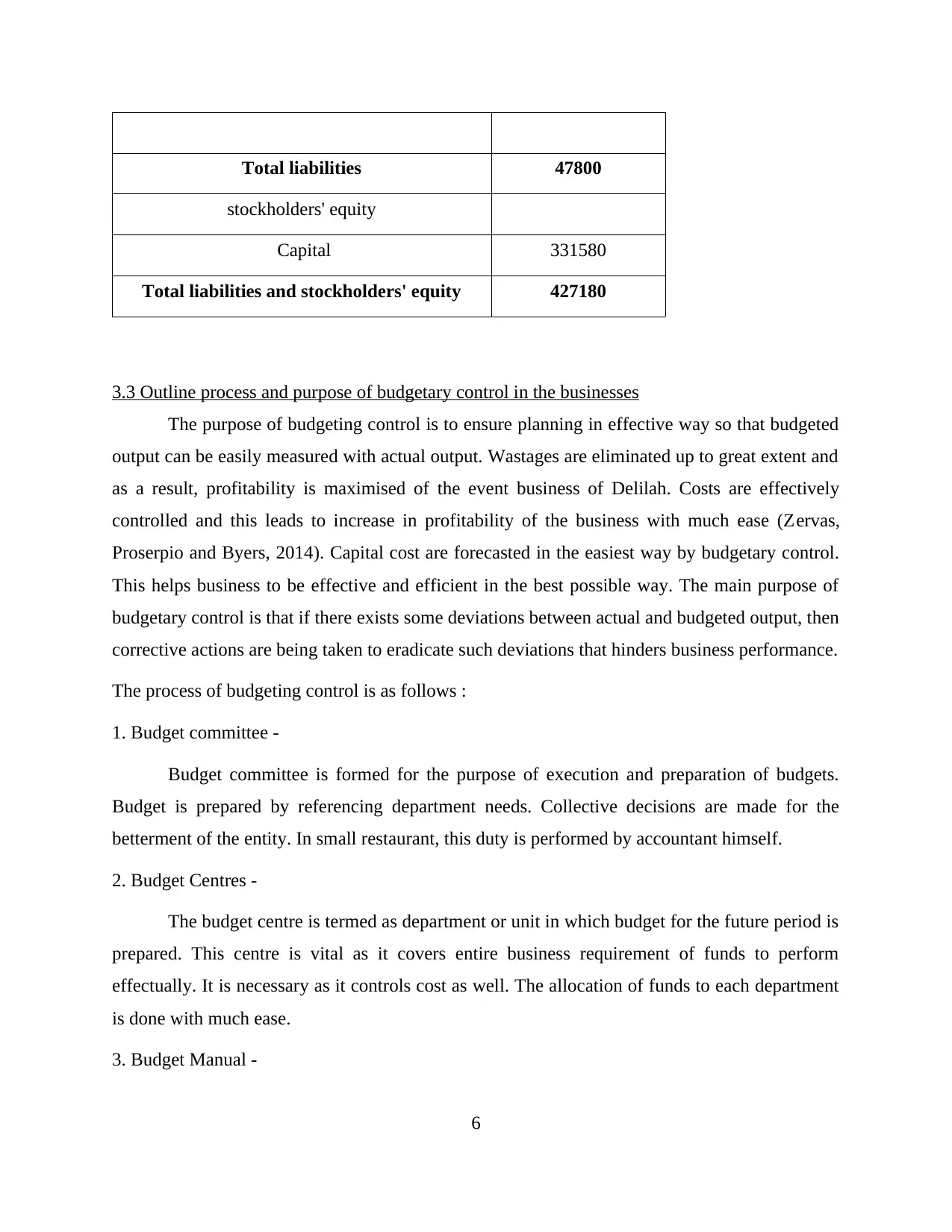
Total liabilities 47800
stockholders' equity
Capital 331580
Total liabilities and stockholders' equity 427180
3.3 Outline process and purpose of budgetary control in the businesses
The purpose of budgeting control is to ensure planning in effective way so that budgeted
output can be easily measured with actual output. Wastages are eliminated up to great extent and
as a result, profitability is maximised of the event business of Delilah. Costs are effectively
controlled and this leads to increase in profitability of the business with much ease (Zervas,
Proserpio and Byers, 2014). Capital cost are forecasted in the easiest way by budgetary control.
This helps business to be effective and efficient in the best possible way. The main purpose of
budgetary control is that if there exists some deviations between actual and budgeted output, then
corrective actions are being taken to eradicate such deviations that hinders business performance.
The process of budgeting control is as follows :
1. Budget committee -
Budget committee is formed for the purpose of execution and preparation of budgets.
Budget is prepared by referencing department needs. Collective decisions are made for the
betterment of the entity. In small restaurant, this duty is performed by accountant himself.
2. Budget Centres -
The budget centre is termed as department or unit in which budget for the future period is
prepared. This centre is vital as it covers entire business requirement of funds to perform
effectually. It is necessary as it controls cost as well. The allocation of funds to each department
is done with much ease.
3. Budget Manual -
6
stockholders' equity
Capital 331580
Total liabilities and stockholders' equity 427180
3.3 Outline process and purpose of budgetary control in the businesses
The purpose of budgeting control is to ensure planning in effective way so that budgeted
output can be easily measured with actual output. Wastages are eliminated up to great extent and
as a result, profitability is maximised of the event business of Delilah. Costs are effectively
controlled and this leads to increase in profitability of the business with much ease (Zervas,
Proserpio and Byers, 2014). Capital cost are forecasted in the easiest way by budgetary control.
This helps business to be effective and efficient in the best possible way. The main purpose of
budgetary control is that if there exists some deviations between actual and budgeted output, then
corrective actions are being taken to eradicate such deviations that hinders business performance.
The process of budgeting control is as follows :
1. Budget committee -
Budget committee is formed for the purpose of execution and preparation of budgets.
Budget is prepared by referencing department needs. Collective decisions are made for the
betterment of the entity. In small restaurant, this duty is performed by accountant himself.
2. Budget Centres -
The budget centre is termed as department or unit in which budget for the future period is
prepared. This centre is vital as it covers entire business requirement of funds to perform
effectually. It is necessary as it controls cost as well. The allocation of funds to each department
is done with much ease.
3. Budget Manual -
6
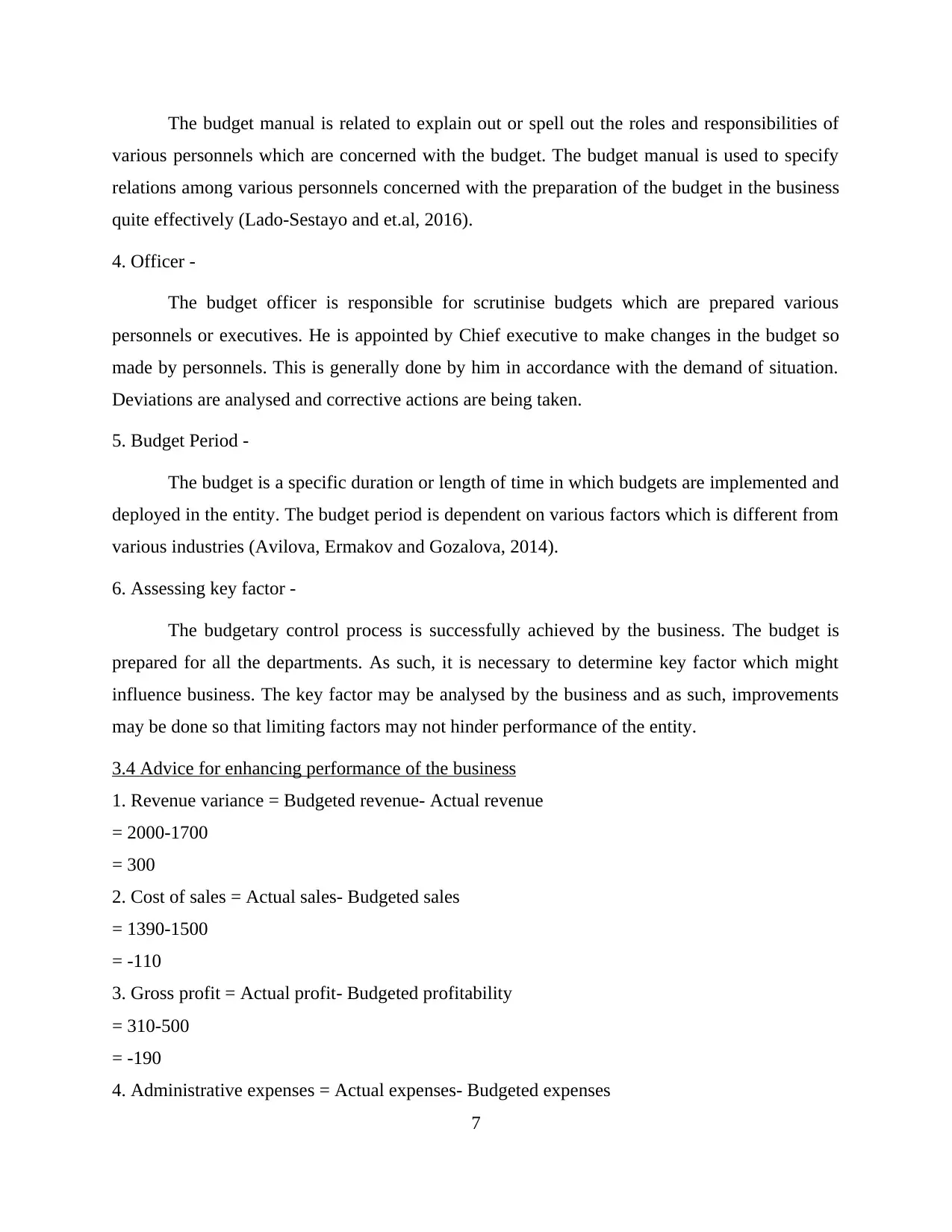
The budget manual is related to explain out or spell out the roles and responsibilities of
various personnels which are concerned with the budget. The budget manual is used to specify
relations among various personnels concerned with the preparation of the budget in the business
quite effectively (Lado-Sestayo and et.al, 2016).
4. Officer -
The budget officer is responsible for scrutinise budgets which are prepared various
personnels or executives. He is appointed by Chief executive to make changes in the budget so
made by personnels. This is generally done by him in accordance with the demand of situation.
Deviations are analysed and corrective actions are being taken.
5. Budget Period -
The budget is a specific duration or length of time in which budgets are implemented and
deployed in the entity. The budget period is dependent on various factors which is different from
various industries (Avilova, Ermakov and Gozalova, 2014).
6. Assessing key factor -
The budgetary control process is successfully achieved by the business. The budget is
prepared for all the departments. As such, it is necessary to determine key factor which might
influence business. The key factor may be analysed by the business and as such, improvements
may be done so that limiting factors may not hinder performance of the entity.
3.4 Advice for enhancing performance of the business
1. Revenue variance = Budgeted revenue- Actual revenue
= 2000-1700
= 300
2. Cost of sales = Actual sales- Budgeted sales
= 1390-1500
= -110
3. Gross profit = Actual profit- Budgeted profitability
= 310-500
= -190
4. Administrative expenses = Actual expenses- Budgeted expenses
7
various personnels which are concerned with the budget. The budget manual is used to specify
relations among various personnels concerned with the preparation of the budget in the business
quite effectively (Lado-Sestayo and et.al, 2016).
4. Officer -
The budget officer is responsible for scrutinise budgets which are prepared various
personnels or executives. He is appointed by Chief executive to make changes in the budget so
made by personnels. This is generally done by him in accordance with the demand of situation.
Deviations are analysed and corrective actions are being taken.
5. Budget Period -
The budget is a specific duration or length of time in which budgets are implemented and
deployed in the entity. The budget period is dependent on various factors which is different from
various industries (Avilova, Ermakov and Gozalova, 2014).
6. Assessing key factor -
The budgetary control process is successfully achieved by the business. The budget is
prepared for all the departments. As such, it is necessary to determine key factor which might
influence business. The key factor may be analysed by the business and as such, improvements
may be done so that limiting factors may not hinder performance of the entity.
3.4 Advice for enhancing performance of the business
1. Revenue variance = Budgeted revenue- Actual revenue
= 2000-1700
= 300
2. Cost of sales = Actual sales- Budgeted sales
= 1390-1500
= -110
3. Gross profit = Actual profit- Budgeted profitability
= 310-500
= -190
4. Administrative expenses = Actual expenses- Budgeted expenses
7
⊘ This is a preview!⊘
Do you want full access?
Subscribe today to unlock all pages.

Trusted by 1+ million students worldwide
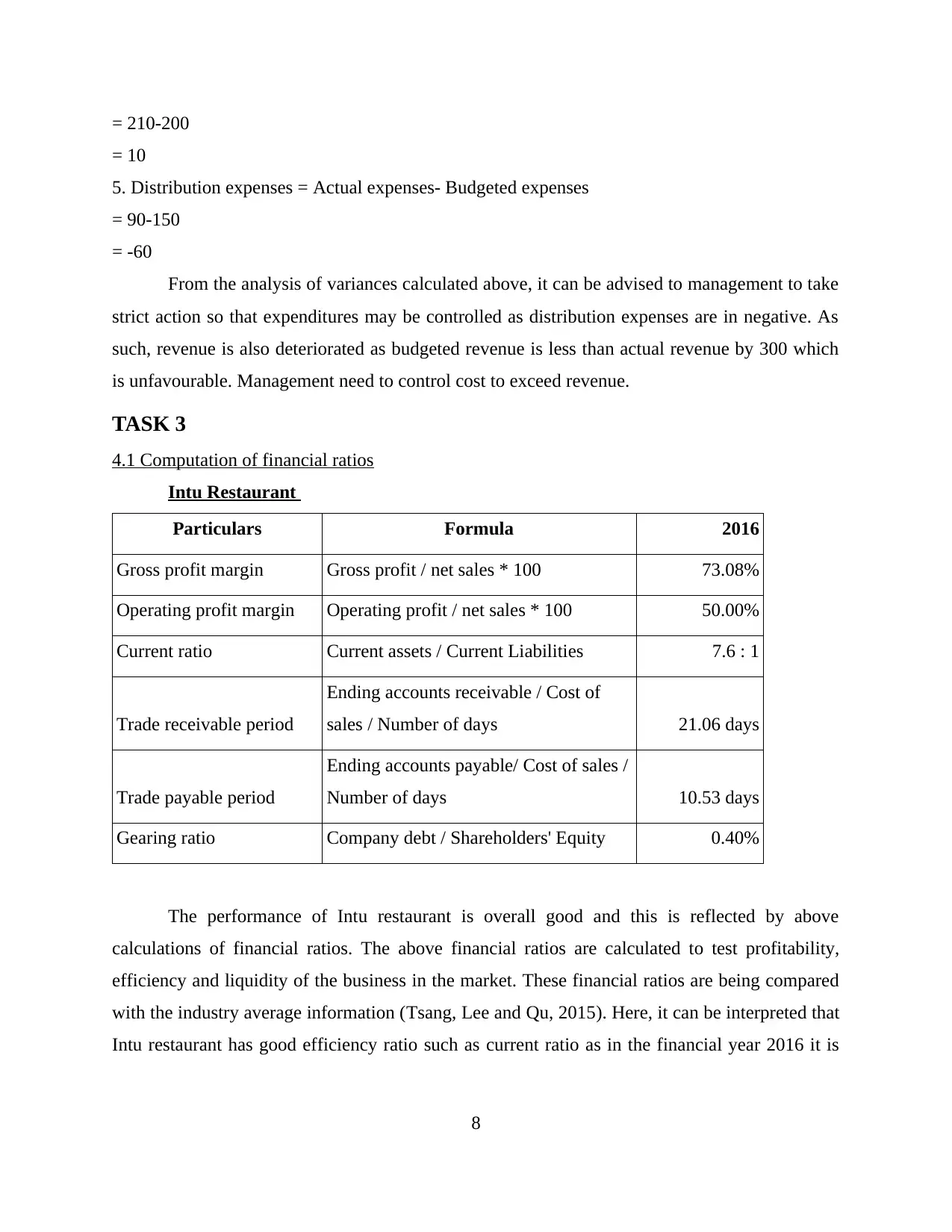
= 210-200
= 10
5. Distribution expenses = Actual expenses- Budgeted expenses
= 90-150
= -60
From the analysis of variances calculated above, it can be advised to management to take
strict action so that expenditures may be controlled as distribution expenses are in negative. As
such, revenue is also deteriorated as budgeted revenue is less than actual revenue by 300 which
is unfavourable. Management need to control cost to exceed revenue.
TASK 3
4.1 Computation of financial ratios
Intu Restaurant
Particulars Formula 2016
Gross profit margin Gross profit / net sales * 100 73.08%
Operating profit margin Operating profit / net sales * 100 50.00%
Current ratio Current assets / Current Liabilities 7.6 : 1
Trade receivable period
Ending accounts receivable / Cost of
sales / Number of days 21.06 days
Trade payable period
Ending accounts payable/ Cost of sales /
Number of days 10.53 days
Gearing ratio Company debt / Shareholders' Equity 0.40%
The performance of Intu restaurant is overall good and this is reflected by above
calculations of financial ratios. The above financial ratios are calculated to test profitability,
efficiency and liquidity of the business in the market. These financial ratios are being compared
with the industry average information (Tsang, Lee and Qu, 2015). Here, it can be interpreted that
Intu restaurant has good efficiency ratio such as current ratio as in the financial year 2016 it is
8
= 10
5. Distribution expenses = Actual expenses- Budgeted expenses
= 90-150
= -60
From the analysis of variances calculated above, it can be advised to management to take
strict action so that expenditures may be controlled as distribution expenses are in negative. As
such, revenue is also deteriorated as budgeted revenue is less than actual revenue by 300 which
is unfavourable. Management need to control cost to exceed revenue.
TASK 3
4.1 Computation of financial ratios
Intu Restaurant
Particulars Formula 2016
Gross profit margin Gross profit / net sales * 100 73.08%
Operating profit margin Operating profit / net sales * 100 50.00%
Current ratio Current assets / Current Liabilities 7.6 : 1
Trade receivable period
Ending accounts receivable / Cost of
sales / Number of days 21.06 days
Trade payable period
Ending accounts payable/ Cost of sales /
Number of days 10.53 days
Gearing ratio Company debt / Shareholders' Equity 0.40%
The performance of Intu restaurant is overall good and this is reflected by above
calculations of financial ratios. The above financial ratios are calculated to test profitability,
efficiency and liquidity of the business in the market. These financial ratios are being compared
with the industry average information (Tsang, Lee and Qu, 2015). Here, it can be interpreted that
Intu restaurant has good efficiency ratio such as current ratio as in the financial year 2016 it is
8
Paraphrase This Document
Need a fresh take? Get an instant paraphrase of this document with our AI Paraphraser
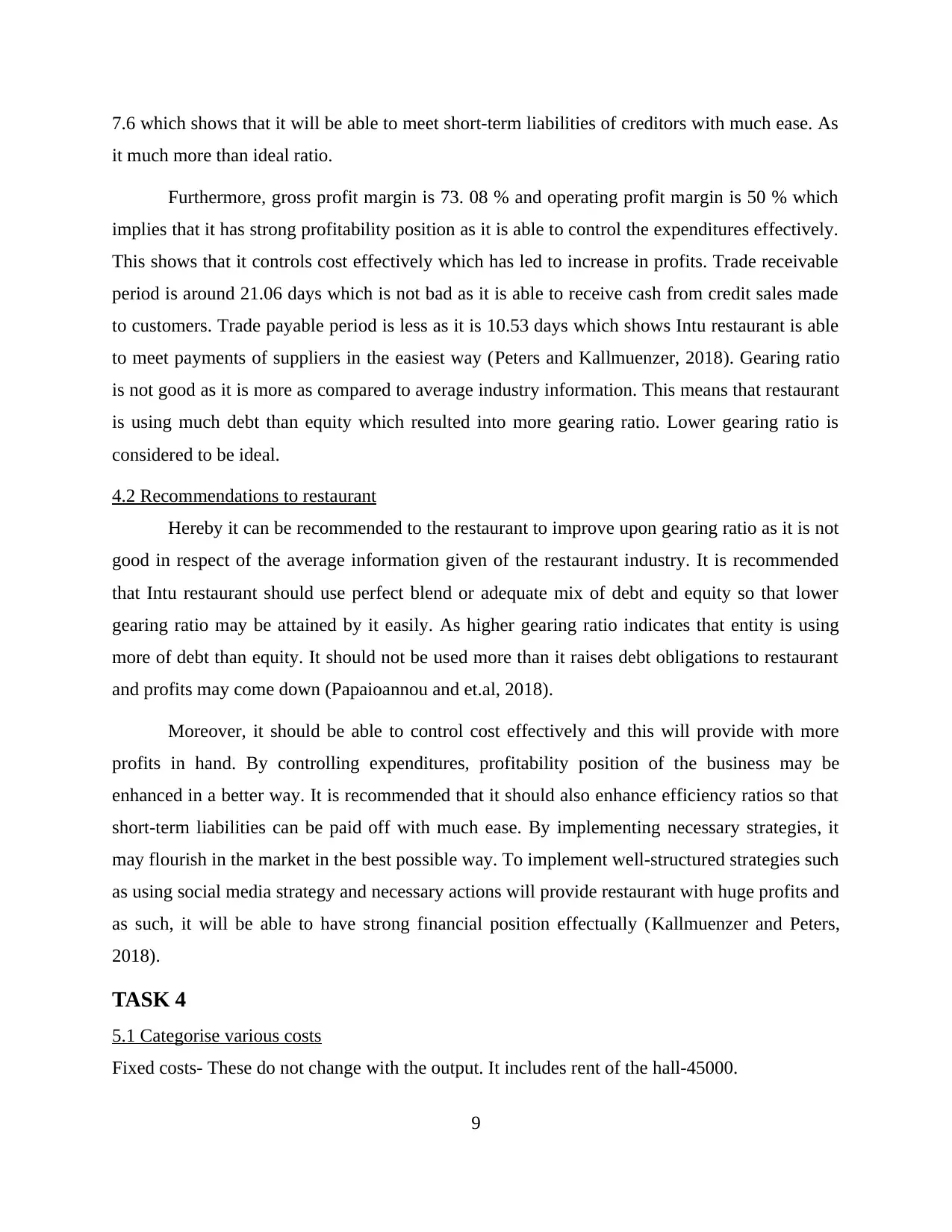
7.6 which shows that it will be able to meet short-term liabilities of creditors with much ease. As
it much more than ideal ratio.
Furthermore, gross profit margin is 73. 08 % and operating profit margin is 50 % which
implies that it has strong profitability position as it is able to control the expenditures effectively.
This shows that it controls cost effectively which has led to increase in profits. Trade receivable
period is around 21.06 days which is not bad as it is able to receive cash from credit sales made
to customers. Trade payable period is less as it is 10.53 days which shows Intu restaurant is able
to meet payments of suppliers in the easiest way (Peters and Kallmuenzer, 2018). Gearing ratio
is not good as it is more as compared to average industry information. This means that restaurant
is using much debt than equity which resulted into more gearing ratio. Lower gearing ratio is
considered to be ideal.
4.2 Recommendations to restaurant
Hereby it can be recommended to the restaurant to improve upon gearing ratio as it is not
good in respect of the average information given of the restaurant industry. It is recommended
that Intu restaurant should use perfect blend or adequate mix of debt and equity so that lower
gearing ratio may be attained by it easily. As higher gearing ratio indicates that entity is using
more of debt than equity. It should not be used more than it raises debt obligations to restaurant
and profits may come down (Papaioannou and et.al, 2018).
Moreover, it should be able to control cost effectively and this will provide with more
profits in hand. By controlling expenditures, profitability position of the business may be
enhanced in a better way. It is recommended that it should also enhance efficiency ratios so that
short-term liabilities can be paid off with much ease. By implementing necessary strategies, it
may flourish in the market in the best possible way. To implement well-structured strategies such
as using social media strategy and necessary actions will provide restaurant with huge profits and
as such, it will be able to have strong financial position effectually (Kallmuenzer and Peters,
2018).
TASK 4
5.1 Categorise various costs
Fixed costs- These do not change with the output. It includes rent of the hall-45000.
9
it much more than ideal ratio.
Furthermore, gross profit margin is 73. 08 % and operating profit margin is 50 % which
implies that it has strong profitability position as it is able to control the expenditures effectively.
This shows that it controls cost effectively which has led to increase in profits. Trade receivable
period is around 21.06 days which is not bad as it is able to receive cash from credit sales made
to customers. Trade payable period is less as it is 10.53 days which shows Intu restaurant is able
to meet payments of suppliers in the easiest way (Peters and Kallmuenzer, 2018). Gearing ratio
is not good as it is more as compared to average industry information. This means that restaurant
is using much debt than equity which resulted into more gearing ratio. Lower gearing ratio is
considered to be ideal.
4.2 Recommendations to restaurant
Hereby it can be recommended to the restaurant to improve upon gearing ratio as it is not
good in respect of the average information given of the restaurant industry. It is recommended
that Intu restaurant should use perfect blend or adequate mix of debt and equity so that lower
gearing ratio may be attained by it easily. As higher gearing ratio indicates that entity is using
more of debt than equity. It should not be used more than it raises debt obligations to restaurant
and profits may come down (Papaioannou and et.al, 2018).
Moreover, it should be able to control cost effectively and this will provide with more
profits in hand. By controlling expenditures, profitability position of the business may be
enhanced in a better way. It is recommended that it should also enhance efficiency ratios so that
short-term liabilities can be paid off with much ease. By implementing necessary strategies, it
may flourish in the market in the best possible way. To implement well-structured strategies such
as using social media strategy and necessary actions will provide restaurant with huge profits and
as such, it will be able to have strong financial position effectually (Kallmuenzer and Peters,
2018).
TASK 4
5.1 Categorise various costs
Fixed costs- These do not change with the output. It includes rent of the hall-45000.
9
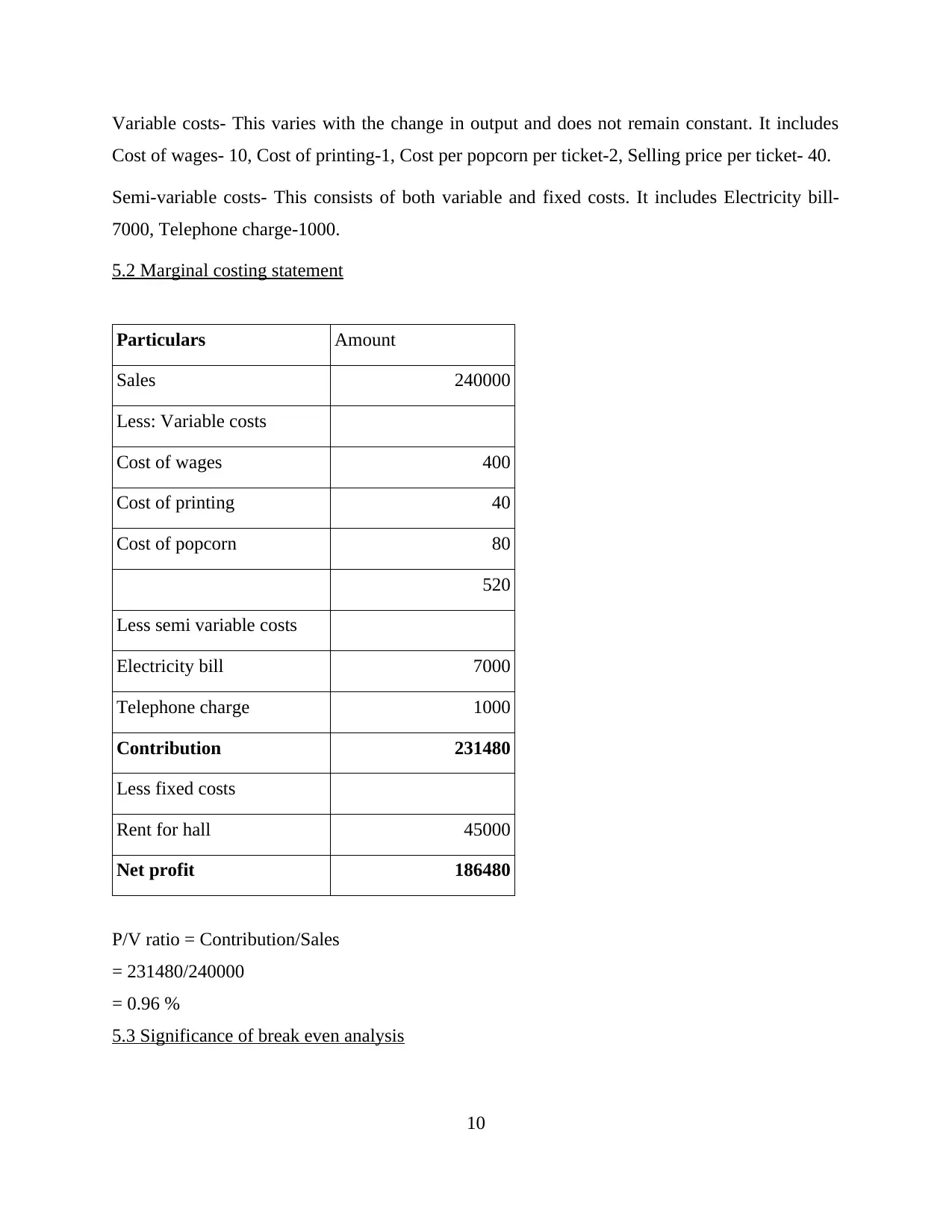
Variable costs- This varies with the change in output and does not remain constant. It includes
Cost of wages- 10, Cost of printing-1, Cost per popcorn per ticket-2, Selling price per ticket- 40.
Semi-variable costs- This consists of both variable and fixed costs. It includes Electricity bill-
7000, Telephone charge-1000.
5.2 Marginal costing statement
Particulars Amount
Sales 240000
Less: Variable costs
Cost of wages 400
Cost of printing 40
Cost of popcorn 80
520
Less semi variable costs
Electricity bill 7000
Telephone charge 1000
Contribution 231480
Less fixed costs
Rent for hall 45000
Net profit 186480
P/V ratio = Contribution/Sales
= 231480/240000
= 0.96 %
5.3 Significance of break even analysis
10
Cost of wages- 10, Cost of printing-1, Cost per popcorn per ticket-2, Selling price per ticket- 40.
Semi-variable costs- This consists of both variable and fixed costs. It includes Electricity bill-
7000, Telephone charge-1000.
5.2 Marginal costing statement
Particulars Amount
Sales 240000
Less: Variable costs
Cost of wages 400
Cost of printing 40
Cost of popcorn 80
520
Less semi variable costs
Electricity bill 7000
Telephone charge 1000
Contribution 231480
Less fixed costs
Rent for hall 45000
Net profit 186480
P/V ratio = Contribution/Sales
= 231480/240000
= 0.96 %
5.3 Significance of break even analysis
10
⊘ This is a preview!⊘
Do you want full access?
Subscribe today to unlock all pages.

Trusted by 1+ million students worldwide
1 out of 15
Related Documents
Your All-in-One AI-Powered Toolkit for Academic Success.
+13062052269
info@desklib.com
Available 24*7 on WhatsApp / Email
![[object Object]](/_next/static/media/star-bottom.7253800d.svg)
Unlock your academic potential
Copyright © 2020–2025 A2Z Services. All Rights Reserved. Developed and managed by ZUCOL.





